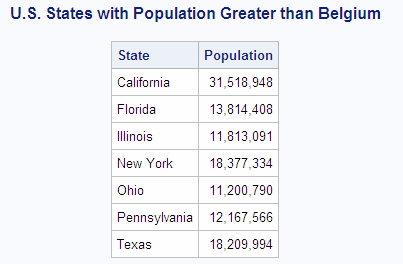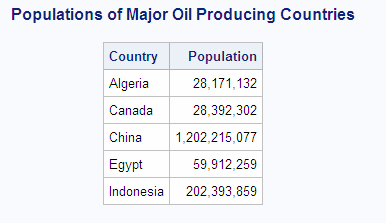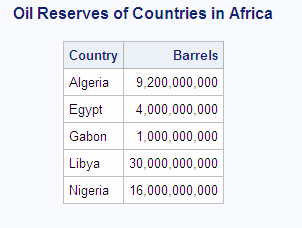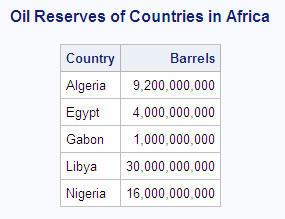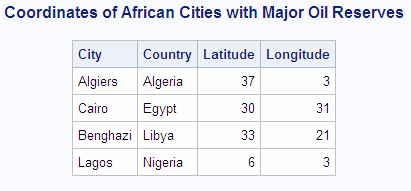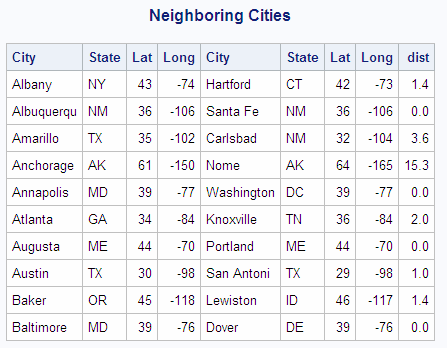Using Subqueries to Select Data
While a table join combines multiple tables into a
new table, a subquery (enclosed in parentheses) selects rows from
one table based on values in another table. A subquery, or inner query,
is a query expression that is nested as part of another query expression.
Depending on the clause that contains it, a subquery can return a
single value or multiple values. Subqueries are most often used in
the WHERE and the HAVING expressions.
Single-Value Subqueries
A single-value
subquery returns a single row and column. It can be used in a WHERE
or HAVING clause with a comparison operator. The subquery must return
only one value, or else the query fails and an error message is printed
to the log.
This query uses a subquery
in its WHERE clause to select U.S. states that have a population greater
than Belgium. The subquery is evaluated first, and then it returns
the population of Belgium to the outer query.
libname sql 'SAS-library';
proc sql;
title 'U.S. States with Population Greater than Belgium';
select Name 'State' , population format=comma10.
from sql.unitedstates
where population gt
(select population from sql.countries
where name = "Belgium");Multiple-Value Subqueries
A multiple-value subquery can return
more than one value from one column. It is used in a WHERE or HAVING
expression that contains IN or a comparison operator that is modified
by ANY or ALL. This example displays the populations of oil-producing
countries. The subquery first returns all countries that are found
in the OILPROD table. The outer query then matches countries in the
COUNTRIES table to the results of the subquery.
libname sql 'SAS-library';
proc sql outobs=5;
title 'Populations of Major Oil Producing Countries';
select name 'Country', Population format=comma15.
from sql.countries
where Name in
(select Country from sql.oilprod);If you use the NOT IN
operator in this query, then the query result will contain all the
countries that are not contained in the OILPROD table.
Correlated Subqueries
The previous subqueries have been
simple subqueries that are self-contained and that execute independently
of the outer query. A correlated subquery requires a value or values
to be passed to it by the outer query. After the subquery runs, it
passes the results back to the outer query. Correlated subqueries
can return single or multiple values.
libname sql 'SAS-library';
proc sql;
title 'Oil Reserves of Countries in Africa';
select * from sql.oilrsrvs o
where 'Africa' =
(select Continent from sql.countries c
where c.Name = o.Country); The outer query selects
the first row from the OILRSRVS table and then passes the value of
the Country column,
Algeria, to the subquery.
At this point, the subquery internally looks like this: (select Continent from sql.countries c
where c.Name = 'Algeria'); The subquery selects
that country from the COUNTRIES table. The subquery then passes the
country's continent back to the WHERE clause in the outer query. If
the continent is Africa, then the country is selected and displayed.
The outer query then selects each subsequent row from the OILRSRVS
table and passes the individual values of Country to the subquery.
The subquery returns the appropriate values of Continent to the outer
query for comparison in its WHERE clause.Note that the WHERE
clause uses an
= (equal) operator. You can
use an = (equal) operator if the subquery
returns only a single value. However, if the subquery returns multiple
values, then you must use IN or a comparison operator with ANY or
ALL. For detailed information about the operators that are available
for use with subqueries, see SQL Procedure.Testing for the Existence of a Group of Values
The EXISTS condition tests for the existence of a set
of values. An EXISTS condition is true if any rows are produced by
the subquery, and it is false if no rows are produced. Conversely,
the NOT EXISTS condition is true when a subquery produces an empty
table.
This example produces
the same result as Correlated Subquery. EXISTS checks for the existence of countries that have oil
reserves on the continent of Africa. Note that the WHERE clause in
the subquery now contains the condition
Continent = 'Africa' that was in the outer query in the previous example.
Multiple Levels of Subquery Nesting
Subqueries can be nested so
that the innermost subquery returns a value or values to be used by
the next outer query. Then, that subquery's value or values are used
by the next outer query, and so on. Evaluation always begins with
the innermost subquery and works outward.
This example lists cities
in Africa that are in countries with major oil reserves.
-
The innermost query is evaluated first. It returns countries that are located on the continent of Africa.
-
The outer subquery is evaluated. It returns a subset of African countries that have major oil reserves by comparing the list of countries that was returned by the inner subquery against the countries in OILRSRVS.
-
Finally, the WHERE clause in the outer query lists the coordinates of the cities that exist in the WORLDCITYCOORDS table whose countries match the results of the outer subquery.
Combining a Join with a Subquery
You can combine joins and subqueries
in a single query. Suppose that you want to find the city nearest
to each city in the USCITYCOORDS table. The query must first select
a city
A, compute the distance from
a city A to every other city, and finally
select the city with the minimum distance from city A. This can be
done by joining the USCITYCOORDS table to itself (self-join) and then
determining the closest distance between cities by using another self-join
in a subquery.
Although the results
of this formula are not exactly accurate because of the distortions
caused by the curvature of the earth, they are accurate enough for
this example to determine whether one city is closer than another.
libname sql 'SAS-library';
proc sql outobs=10;
title 'Neighboring Cities';
select a.City format=$10., a.State,
a.Latitude 'Lat', a.Longitude 'Long',
b.City format=$10., b.State,
b.Latitude 'Lat', b.Longitude 'Long',
sqrt(((b.latitude-a.latitude)**2) +
((b.longitude-a.longitude)**2)) as dist format=6.1
from sql.uscitycoords a, sql.uscitycoords b
where a.city ne b.city and
calculated dist =
(select min(sqrt(((d.latitude-c.latitude)**2) +
((d.longitude-c.longitude)**2)))
from sql.uscitycoords c, sql.uscitycoords d
where c.city = a.city and
c.state = a.state and
d.city ne c.city)
order by a.city;The outer query joins
the table to itself and determines the distance between the first
city A1 in table A and city B2 (the first city that is not equal to
city A1) in Table B. PROC SQL then runs the subquery. The subquery
does another self-join and calculates the minimum distance between
city A1 and all other cities in the table other than city A1. The
outer query tests to see whether the distance between cities A1 and
B2 is equal to the minimum distance that was calculated by the subquery.
If they are equal, then a row that contains cities A1 and B2 with
their coordinates and distance is written.
Copyright © SAS Institute Inc. All rights reserved.
